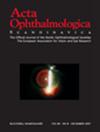Aniridia associated keratopathy – molecular and clinical mechanisms leading to keratopathy development
Abstract
Congenital aniridia is a rare, panocular disease with PAX6 haploinsufficiency in 90% of the cases. In addition to PAX6, other factors appear to play a role in aniridia associated keratopathy (AAK) development. FOXC1, DSG1, FOSL2 and FABP5 are genes that are crucial for eye development, differentiation of limbal stem cells and for the regulation of lipid metabolism in epithelial cells. Recent data also indicate the importance of microRNA 204-5p and microRNA 138-5p in AAK. The Lagali AAK classification well describes the progressive nature of AAK, from a mild peripheral to a central corneal vascularization with corneal pannus formation. Ocular surface inflammation, as much as previous ocular surgery seem to have a role in AAK progression. Nevertheless, the corneal endothelium might possess slightly better quantitative reserves in congenital aniridia, than in healthy subjects and corneal endothelial deposition seems to be independent from the developmental abnormalities but may be related to up to date undescribed endothelial inflammatory or metabolic changes.

 求助内容:
求助内容: 应助结果提醒方式:
应助结果提醒方式:


